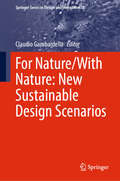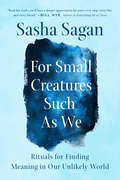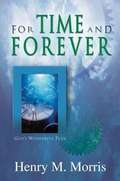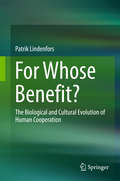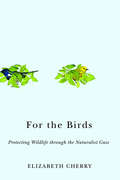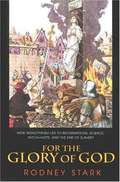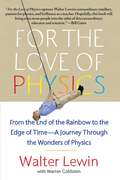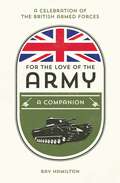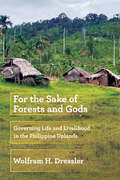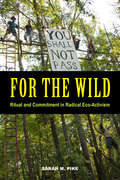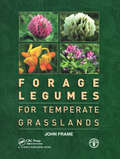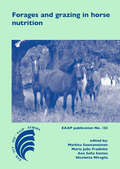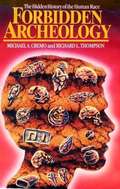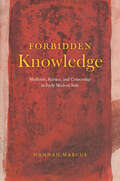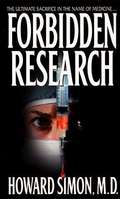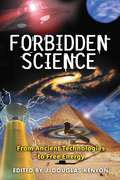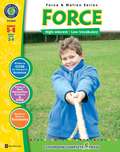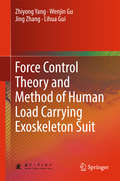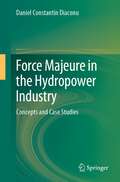- Table View
- List View
For Good Measure: The Ways We Say How Much, How Far, How Heavy, How Big, How Old
by Ken RobbinsThe book presents some facts about units of measure, and how they compare to one another. The author has included the widely used metric equivalents of most measures that are mentioned.
For Nature/With Nature: New Sustainable Design Scenarios (Springer Series in Design and Innovation #38)
by Claudio GambardellaThis volume contributes to the construction of a multi-voice mosaic on the theme of Nature and the relationship between Man (understood as designer) and Nature by emphasizing the innovative and sustainable proposals coming from the discipline of design, in its many facets and interdisciplinary contributions. Since it isn’t discussed the creative and economic effort that designers, institutions and companies have been leading for years to improve human living conditions, preference will be given to scientific contributions (unpublished or not yet fully known case studies, projects of strategies, products, systems and services, theoretical contributions, communication) that are an expression of a new approach to Nature, seen as our ally and object of an ethics of care. The focus is the design both in its role as innovation driver and interpreter of social evolution, that must be considered within the human-nature relationship. The topics identify some of the most relevant fields of development in which "Design Driven Innovation" can be developed in the respect of perspective of a new relationship with nature.
For Small Creatures Such as We: Rituals for Finding Meaning in Our Unlikely World
by Sasha Sagan"What is the meaning of life? Sagan finds its meaning everywhere--with her family, around the world, and especially among the stars of the cosmos. Read her work; you'll have a deeper appreciation for your every step, every bite, and every breath." --Bill NyePart memoir, part guidebook, and part social history, For Small Creatures Such as We is the first book from the daughter of Carl Sagan and Ann Druyan--a luminous exploration of Earth's marvels that require no faith in order to be believed.Sasha Sagan was raised by secular parents, the astronomer Carl Sagan and the writer and producer Ann Druyan. They taught her that the natural world and vast cosmos are full of profound beauty, that science reveals truths more wondrous than any myth or fable. When Sagan herself became a mother, she began her own hunt for the natural phenomena behind our most treasured occasions--from births to deaths, holidays to weddings, anniversaries, and more--growing these roots into a new set of rituals for her young daughter that honor the joy and significance of each experience without relying on religious framework.As Sagan shares these rituals, For Small Creatures Such as We becomes a moving tribute to a father, a newborn daughter, a marriage, and the natural world--a celebration of life itself, and the power of our families and beliefs to bring us together.
For Time and Forever
by Dr Henry M. MorrisIs all life a result of random processes? We plan our lives and daily routines, but is there a "plan"? Does someone manage individual lives and the order of the universe? The answer for people of faith, of course, is that God controls all things. The logical conclusion of that belief is that He also has a plan for each individual, and a plan for Earth itself. Man was created to have dominion over the planet, to care for it and its creatures. In For Time and Forever, Bible authority Henry Morris explores the breadth of what it means to have purpose in God's creation. Besides debunking evolutionary myths, Dr. Morris also answers the cry of man: where do I fit? Does God have a purpose for me? Morris recognizes that since our time is short in terms of life span, we must all work to fulfill the Great Commission: we must recognize the biblical truth that there is an overall plan of salvation and we must work to implement it. Answering age-old questions like "Why do bad things happen?" and "Is there a heaven and a hell?" Morris provides a framework for laymen and scholars alike to see their true purposes.
For Whose Benefit?
by Patrik LindenforsThis book takes the reader on a journey, navigating the enigmatic aspects of cooperation; a journey that starts inside the body and continues via our thoughts to the human super-organism. Cooperation is one of life's fundamental principles. We are all made of parts - genes, cells, organs, neurons, but also of ideas, or 'memes'. Our societies too are made of parts - us humans. Is all this cooperation fundamentally the same process? From the smallest component parts of our bodies and minds to our complicated societies, everywhere cooperation is the organizing principle. Often this cooperation has emerged because the constituting parts have benefited from the interactions, but not seldom the cooperating units appear to lose on the interaction. How then to explain cooperation? How can we understand our intricate societies where we regularly provide small and large favors for people we are unrelated to, know, or even never expect to meet again? Where does the idea come from that it is right to risk one's life for country, religion or freedom? The answers seem to reside in the two processes that have shaped humanity: biological and cultural evolution.
For the Birds: Protecting Wildlife through the Naturalist Gaze (Nature, Society, and Culture)
by Elizabeth CherryOne in five people in the United States is a birdwatcher, yet the popular understanding of birders reduces them to comical stereotypes, obsessives who only have eyes for their favorite rare species. In real life, however, birders are paying equally close attention to the world around them, observing the devastating effects of climate change and mass extinction, while discovering small pockets of biodiversity in unexpected places. For the Birds offers readers a glimpse behind the binoculars and reveals birders to be important allies in the larger environmental conservation movement. With a wealth of data from in-depth interviews and over three years of observing birders in the field, environmental sociologist Elizabeth Cherry argues that birders learn to watch wildlife in ways that make an invaluable contribution to contemporary conservation efforts. She investigates how birders develop a “naturalist gaze” that enables them to understand the shared ecosystem that intertwines humans and wild animals, an appreciation that motivates them to participate in citizen science projects and wildlife conservation.
For the Glory of God: How Monotheism Led to Reformations, Science, Witch-Hunts, and the End of Slavery
by Rodney StarkRodney Stark's provocative new book argues that, whether we like it or not, people acting for the glory of God have formed our modern culture. Continuing his project of identifying the widespread consequences of monotheism, Stark shows that the Christian conception of God resulted--almost inevitably and for the same reasons--in the Protestant Reformation, the rise of modern science, the European witch-hunts, and the Western abolition of slavery. In the process, he explains why Christian and Islamic images of God yielded such different cultural results, leading Christians but not Muslims to foster science, burn "witches," and denounce slavery. With his usual clarity and skepticism toward the received wisdom, Stark finds the origins of these disparate phenomena within monotheistic religious organizations. Endemic in such organizations are pressures to maintain religious intensity, which lead to intense conflicts and schisms that have far-reaching social results. Along the way, Stark debunks many commonly accepted ideas. He interprets the sixteenth-century flowering of science not as a sudden revolution that burst religious barriers, but as the normal, gradual, and direct outgrowth of medieval theology. He also shows that the very ideas about God that sustained the rise of science led also to intense witch-hunting by otherwise clear-headed Europeans, including some celebrated scientists. This conception of God likewise yielded the Christian denunciation of slavery as an abomination--and some of the fiercest witch-hunters were devoted participants in successful abolitionist movements on both sides of the Atlantic. For the Glory of God is an engrossing narrative that accounts for the very different histories of the Christian and Muslim worlds. It fundamentally changes our understanding of religion's role in history and the forces behind much of what we point to as secular progress.
For the Love of Physics: From the End of the Rainbow to the Edge Of Time - A Journey Through the Wonders of Physics
by Walter Lewin“YOU HAVE CHANGED MY LIFE” is a common refrain in the emails Walter Lewin receives daily from fans who have been enthralled by his world-famous video lectures about the wonders of physics. “I walk with a new spring in my step and I look at life through physics-colored eyes,” wrote one such fan. When Lewin’s lectures were made available online, he became an instant YouTube celebrity, and The New York Times declared, “Walter Lewin delivers his lectures with the panache of Julia Child bringing French cooking to amateurs and the zany theatricality of YouTube’s greatest hits.” For more than thirty years as a beloved professor at the Massachusetts Institute of Technology, Lewin honed his singular craft of making physics not only accessible but truly fun, whether putting his head in the path of a wrecking ball, supercharging himself with three hundred thousand volts of electricity, or demonstrating why the sky is blue and why clouds are white. Now, as Carl Sagan did for astronomy and Brian Green did for cosmology, Lewin takes readers on a marvelous journey in For the Love of Physics, opening our eyes as never before to the amazing beauty and power with which physics can reveal the hidden workings of the world all around us. “I introduce people to their own world,” writes Lewin, “the world they live in and are familiar with but don’t approach like a physicist—yet.” Could it be true that we are shorter standing up than lying down? Why can we snorkel no deeper than about one foot below the surface? Why are the colors of a rainbow always in the same order, and would it be possible to put our hand out and touch one? Whether introducing why the air smells so fresh after a lightning storm, why we briefly lose (and gain) weight when we ride in an elevator, or what the big bang would have sounded like had anyone existed to hear it, Lewin never ceases to surprise and delight with the extraordinary ability of physics to answer even the most elusive questions. Recounting his own exciting discoveries as a pioneer in the field of X-ray astronomy—arriving at MIT right at the start of an astonishing revolution in astronomy—he also brings to life the power of physics to reach into the vastness of space and unveil exotic uncharted territories, from the marvels of a supernova explosion in the Large Magellanic Cloud to the unseeable depths of black holes. “For me,” Lewin writes, “physics is a way of seeing—the spectacular and the mundane, the immense and the minute—as a beautiful, thrillingly interwoven whole.” His wonderfully inventive and vivid ways of introducing us to the revelations of physics impart to us a new appreciation of the remarkable beauty and intricate harmonies of the forces that govern our lives.
For the Love of the Army: A Celebration of the British Armed Forces
by Ray HamiltonFrom the heroes, regiments and famous battles of the British Army’s impressive history to the service people of today, this book celebrates the achievements and ongoing importance of the UK’s land force. It also explores the skills, weaponry and equipment necessary to keep the Army battle-ready and able to face any challenge.
For the Love of the Army: A Celebration of the British Armed Forces
by Ray HamiltonFrom the heroes, regiments and famous battles of the British Army’s impressive history to the service people of today, this book celebrates the achievements and ongoing importance of the UK’s land force. It also explores the skills, weaponry and equipment necessary to keep the Army battle-ready and able to face any challenge.
For the Sake of Forests and Gods: Governing Life and Livelihood in the Philippine Uplands
by Wolfram H. DresslerFor the Sake of Forests and Gods documents the consequences of nonstate actors impinging on the existence of Indigenous peoples in the remote highlands of Palawan Island, the Philippines. Nimble, focused, and well-funded, religious and environmental organizations increasingly assume governmental authority over the lives and livelihoods of the Pala'wan people within their ancestral territories.Wolfram H. Dressler traces these actors' history and contemporary practices, revealing how they bypass the state to govern the less governed. In the highlands, environmental NGOs valorize customary objects and practices to suppress swidden and support forest conservation, while evangelical missionaries regulate Pala'wan beliefs, health, and hygiene.Bridging material studies and biopolitics, For the Sake of Forests and Gods explores how these nonstate actors use customary objects for comprehensive reforms of Pala'wan bodies and souls, centering on how the unique properties of the Tingkep basket mediate nonstate biopower. These reforms impact highlanders differently: some adopt biopolitical ideals willingly, others for political and economic gain. Yet others resist interventions, prioritizing family livelihoods. Ultimately, Dressler argues that Indigenous sovereignty matters more than ever as nonstate biopower intensifies in Southeast Asia's uplands.
For the Wild: Ritual and Commitment in Radical Eco-Activism
by Sarah M. PikeFor the Wild explores the ways in which the commitments of radical environmental and animal-rights activists develop through powerful experiences with the more-than-human world during childhood and young adulthood. The book addresses the question of how and why activists come to value nonhuman animals and the natural world as worthy of protection. Emotions and memories of wonder, love, compassion, anger, and grief shape activists’ protest practices and help us understand their deep-rooted dedicaztion to the planet and its creatures. Drawing on analyses of activist art, music, and writings, as well as interviews and participant-observation in activist communities, Sarah M. Pike delves into the sacred duties of these often misunderstood and marginalized groups with openness and sensitivity.
Forage Legumes for Temperate Grasslands
by John FrameWith the underpinning role of forage legumes in the nitrogen economy and animal productivity from temperate grasslands certain to expand in the future, particularly in regions where their potential has not yet been realized, it is essential that the wealth of information currently available is widely disseminated. This book serves the purpose with
Forages and grazing in horse nutrition
by Nicoletta Miraglia Maria João Fradinho Ana Sofia Santos Markku SaastamoinenForages should be the basis of all diets in horse feeding. Therefore it is of major importance to determine which parameters will influence their quality. Changes on chemical composition along the vegetative cycle, nutrient losses during harvesting, preservation and storage are factors that could have an effect on nutritive value, as well on digestibility and palatability. A specific grazing and ingesting behaviour, linked to plant preferences and the selection of feeding sites will have an impact on biodiversity. This will determine the options on plant species and varieties and further management of pastures for horses. This book highlights the role of forages and grazing in horse nutrition and also gathers information about related topics, such as the contribution of local breeds for the sustainability and development of rural areas, their impact on landscape and relationships with environmental preservation. This book is the 6th volume in a scientific series conceived through the European Workshop on Equine Nutrition (EWEN) which falls under the umbrella of the Horse Commission of the European Federation of Animal Science (EAAP). All these materials provide an interesting basis for further discussion, not only in specialized forums, but also for those involved in horse production.
Foraminifera and their Applications
by Robert Wynn JonesIn a one-stop resource, this book provides a state-of-the-art overview of all aspects of pure and applied forams studies. Building from introductory chapters on the history of foraminiferal research, and research methods, the book then takes the reader through biology, ecology, palaeoecology, biostratigraphy and sequence stratigraphy. This is followed by key chapters detailing practical applications of forams in petroleum geology, mineral geology, engineering geology, environmental science and archaeology. All applications are fully supported by numerous case studies selected from around the world, providing a wealth of real-world data. The book also combines lavish illustrations, including over 70 stunning original picture-diagrams of foraminifera, with comprehensive references for further reading, and online data tables providing additional information on hundreds of foram families and species. Accessible and practical, this is a vital resource for graduate students, academic micropalaeontologists and professionals across all disciplines and industry settings which make use of foram studies.
Forbidden Archeology
by Michael A. Cremo Richard L. ThompsonThe hidden history of the human race, a remarkably complete review of the scientific evidence concerning human origins.
Forbidden Knowledge: Medicine, Science, and Censorship in Early Modern Italy
by Hannah MarcusForbidden Knowledge explores the censorship of medical books from their proliferation in print through the prohibitions placed on them during the Counter-Reformation. How and why did books banned in Italy in the sixteenth century end up back on library shelves in the seventeenth? Historian Hannah Marcus uncovers how early modern physicians evaluated the utility of banned books and facilitated their continued circulation in conversation with Catholic authorities. Through extensive archival research, Marcus highlights how talk of scientific utility, once thought to have begun during the Scientific Revolution, in fact began earlier, emerging from ecclesiastical censorship and the desire to continue to use banned medical books. What’s more, this censorship in medicine, which preceded the Copernican debate in astronomy by sixty years, has had a lasting impact on how we talk about new and controversial developments in scientific knowledge. Beautiful illustrations accompany this masterful, timely book about the interplay between efforts at intellectual control and the utility of knowledge.
Forbidden Research
by Howard Simonmedical thriller in which animal rights activist-terrorists will stop at nothing to put an end to animal-based scientific research
Forbidden Science: From Ancient Technologies to Free Energy
by J. Douglas KenyonReveals the cutting edge of New Science and shows how established science disallows inquiry that challenges the status quo--even when it produces verifiable results • Contains 43 essays by 19 researchers denoting cutting-edge, heretical, or suppressed scientific research, including Immanuel Velikovsky, Nikola Tesla, Rupert Sheldrake, and Masaru Emoto • Edited by Atlantis Rising publisher, J. Douglas KenyonFollowing the model of his bestselling Forbidden History and Forbidden Religion, J. Douglas Kenyon has assembled from his bimonthly journal, Atlantis Rising, material that explores science and technology that has been suppressed by the orthodox scientific community--from the true function of the Great Pyramid and the megaliths at Nabta Playa to Immanuel Velikovsky’s astronomical insights, free energy from space, cold fusion, and Rupert Sheldrake’s research into telepathy and ESP.There is an organized war going on in science between materialistic theory and anything that could be termed spiritual or metaphysical. For example, Masaru Emoto’s research into the energetics of water, although supported by photographic evidence, has been scoffed at by mainstream science because he has asserted that humans affect their surroundings with their thoughts. The materialism or absolute skepticism of the scientific establishment is detrimental to any scientific inquiry that thinks outside the box. This mentality is interested in preserving funding for its own projects, those that will not rock the establishment. From Tesla’s discovery of alternating current to Robert Schoch’s re-dating of the Sphinx, this book serves as a compelling introduction to the true history of alternative and New Science research.
Force (Force & Motion)
by George GraybillThis books provides ready-to-use information and activities for remedial students in grades five to eight. Written to grade using simplified language and vocabulary, science concepts are presented in a way that makes them more accessible to students and easier for them to understand. Comprised of reading passages, student activities and overhead transparencies, our resource can be used effectively for whole-class, small group and independent work.
Force Control Theory and Method of Human Load Carrying Exoskeleton Suit
by Jing Zhang Zhiyong Yang Wenjin Gu Lihua GuiThis book reports on the latest advances in concepts and further development of principal component analysis (PCA), discussing in detail a number of open problems related to dimensional reduction techniques and their extensions. It brings together research findings, previously scattered throughout many scientific journal papers worldwide, and presents them in a methodologically unified form. Offering vital insights into the subject matter in self-contained chapters that balance the theory and concrete applications, and focusing on open problems, it is essential reading for all researchers and practitioners with an interest in PCA
Force Majeure in the Hydropower Industry: Concepts and Case Studies
by Daniel Constantin DiaconuThis book aims to highlight the particular situation faced by certain hydropower companies by the fact that they cannot fulfil their contracts due to force majeure. The first part of this book will be an analysis of how water is used in electricity production. It is important to point out that all types of energy sources use water, to a different extent, of course, and that its spatial and temporal availability is very important. The focus will be on hydropower, presenting the current situation at the global level, and the effect of reducing the amounts of water in the river system.The second part is based on the presentation of the concept of force majeure and the ways of presenting and drafting it in a contract. Many disputes or the success of a contract depended heavily on the provisions of this article of the contract. Obviously, there are also situations in which the signatory parties abuse or are not protected by these provisions of force majeure. Starting from a few brief examples from the international level, we reach a wide discussion of the situation created in Romania, when the largest supplier of electricity produced on the basis of water terminates several contracts invoking force majeure. The manner in which the opinion of the parties involved is presented to the court is analyzed and presented in detail.
Force and Motion Engineering Internship, Engineering Notebook with Article Compilation
by Lawrence Hall of ScienceHow can you get critical supplies to people in need after a natural disaster? If you drop a pod of supplies, what pod materials and features will make safe and successful delivery of food and medical supplies? That’s what you will figure out as you and your classmates take on the role of mechanical engineering interns with Futura Engineering, a company that specializes in designing solutions for the world’s problems. As an intern, you will work to apply your knowledge of forces and motion to help design a pod that will deliver emergency aid packages to people in remote areas where disasters such as earthquakes, landslides, or floods have made it dangerous or impossible to deliver aid by trucks. You will design and test your pod using a digital tool called SupplyDrop, and consider different design aspects: the pod’s shell material, the type and amount of internal padding, and whether you will add additional external features like a parachute or landing legs to your pod. Your supply pod design must protect the cargo by minimizing damage to supplies, offer possibilities for reusing the pod’s shell for shelter, and be as low-cost as possible.

